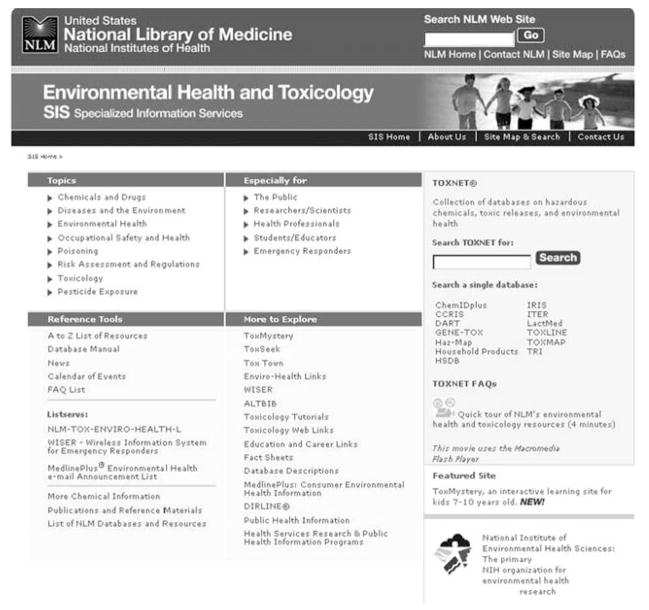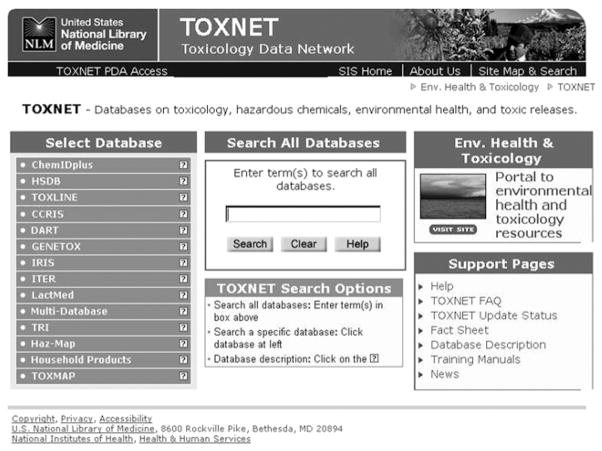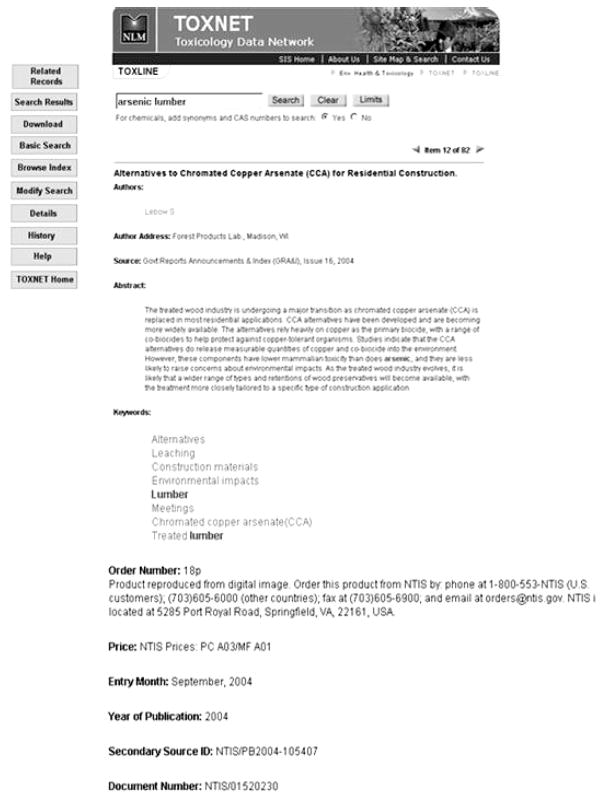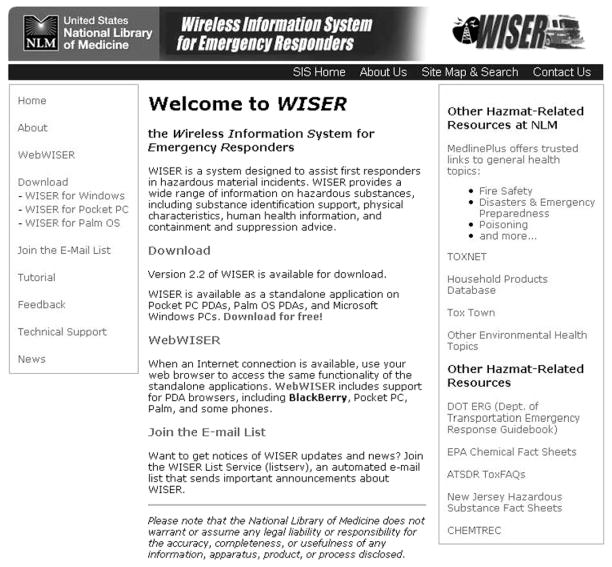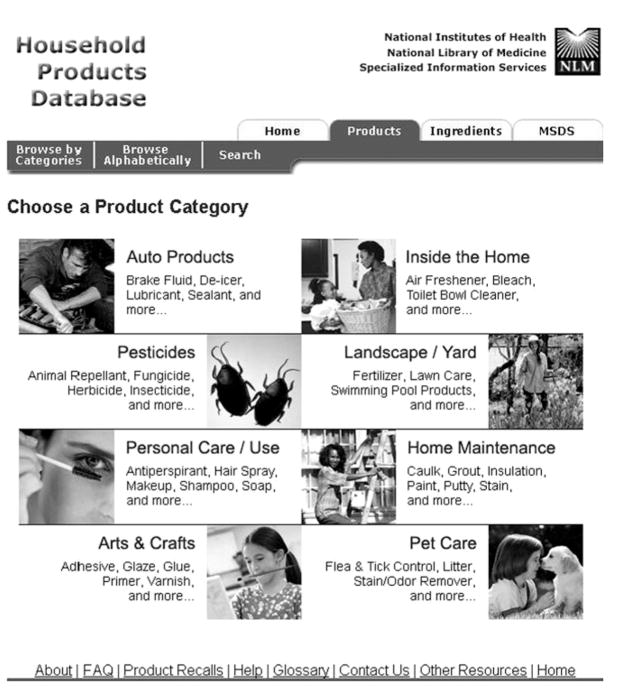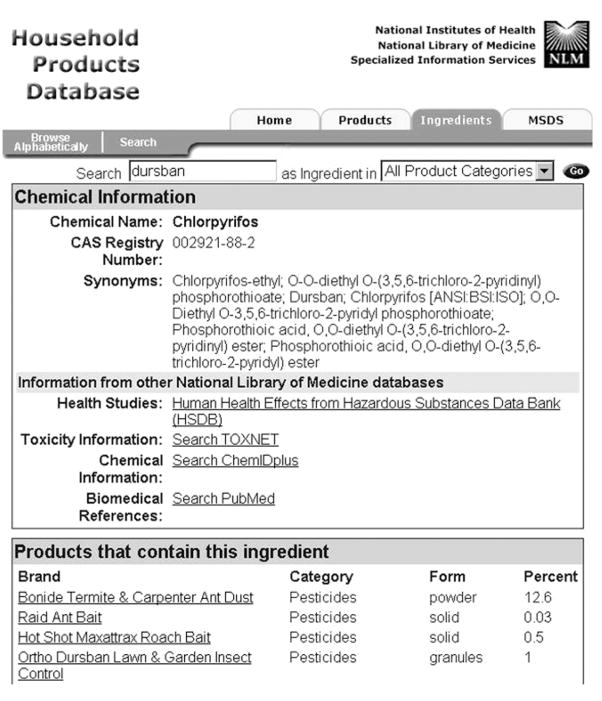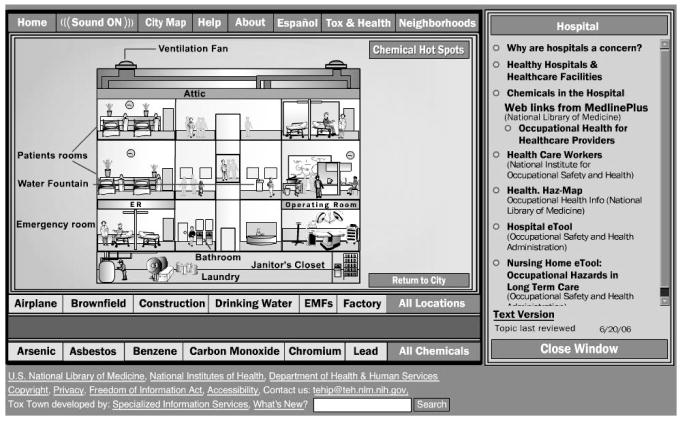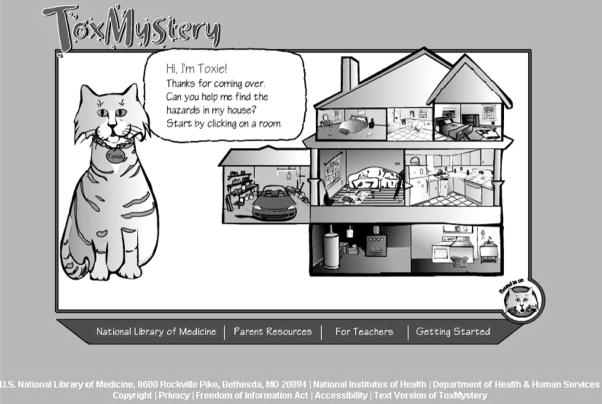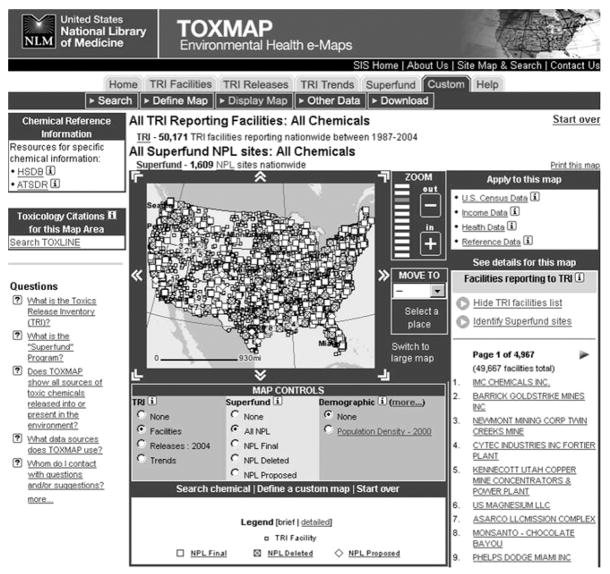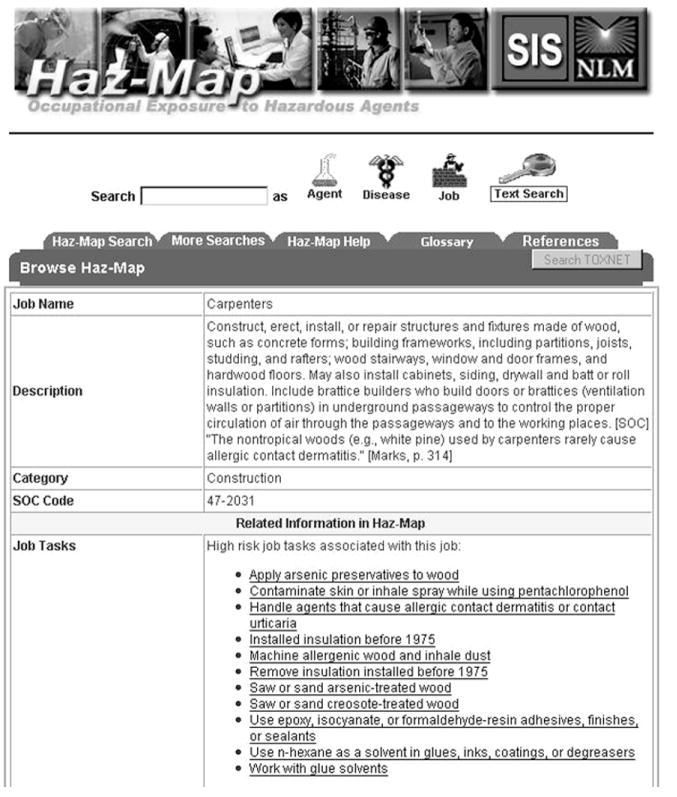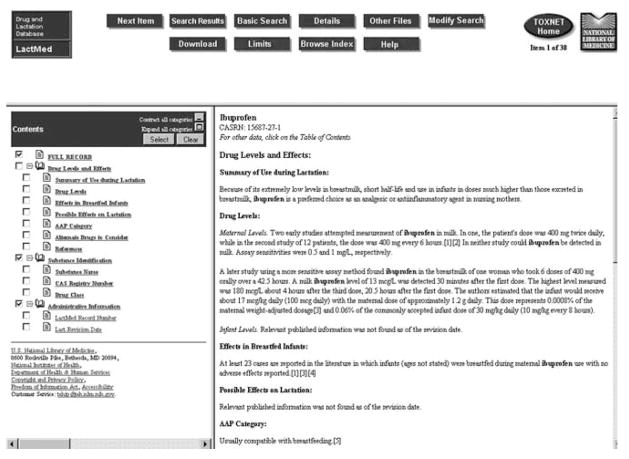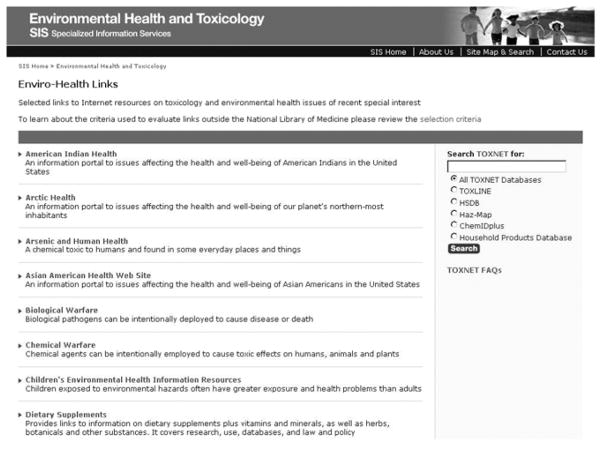Abstract
For over 40 years, the National Library of Medicine’s (NLM) Toxicology and Environmental Health Information Program (TEHIP) has worked to organize and to provide access to an extensive array of environmental health and toxicology resources. During these years, the TEHIP program has evolved from a handful of databases developed primarily for researchers to a broad range of products and services that also serve industry, students, and the general public. TEHIP’s resources include TOXNET® <http://toxnet.nlm.nih.gov>, a collection of databases, including online handbooks, bibliographic references, information on the release of chemicals in the environment, and a chemical dictionary. TEHIP also produces several resources aimed towards the general public, such as the Household Products Database <http://hpd.nlm.nih.gov>, which helps users explore chemicals often found in common household products, and Tox Town® <http://toxtown.nlm.nih.gov>, an interactive guide to commonly encountered toxic substances, health, and the environment. This paper introduces some of NLM’s environmental health and toxicology resources.
Keywords: Toxicology, environment, environmental health, chemicals, databanks, databases, hazardous substances, health, public health, information services, Internet, National Library of Medicine (U.S.), Specialized Information Services, TOXNET, TEHIP
INTRODUCTION
It is now widely accepted that a complex relationship exists between the health of the environment and the health of those living in it. In the early 1960s, news about the adverse effects of drugs, pesticides, and other chemicals caused a growing concern about the harmful effects of substances in our food, water, and in the environment. U.S. citizens called on their government to provide information about environmental issues, including potential human health effects. During that time, the National Institutes of Health completed a study about the effects of environmental chemical contaminants. This in turn prompted the President’s Science Advisory Committee (PSAC) to formally identify “an urgent need for a much more coordinated and more complete computer-based file of toxicology information than any currently available,” and to make “access to this file … more generally available to all those legitimately needing such information.”1
Responsibility for this effort went to the National Library of Medicine (NLM), the world’s largest medical library, and a leader in the selection, acquisition, organization, and provision of medically related literature and data. NLM is part of the National Institutes of Health (NIH), within the Department of Health & Human Services (HHS). Its Toxicology and Environmental Health Information Program (TEHIP), mandated by the legislative response to the PSAC report, became part of NLM’s Division of Specialized Information Services (SIS). (For a list of federal government acronyms used in this document with their expansions, see Table 1.)
TABLE 1.
Guide to Federal Government Acronyms
| ATSDR | United States Centers for Disease Control and Prevention’s Agency for Toxic Substances and Disease Registry |
| CDC | United States Centers for Disease Control and Prevention |
| EPA | United States Environmental Protection Agency |
| CERCLA | Comprehensive Environmental Response, Compensation, and Liability Act |
| HHS | United States Department of Health and Human Services |
| NIH | United States National Institutes of Health |
| NLM | United States National Institutes of Health’s National Library of Medicine |
| NPL | National Priorities List |
| SIS | United States National Library of Medicine’s Division of Specialized Information Services |
| TEHIP | National Library of Medicine’s Toxicology and Environmental Health Information Program |
| TOXNET | National Library of Medicine’s Toxicology Data Network |
| TRI | United States Environmental Protection Agency’s Toxics Release Inventory |
| USGS | United States Geological Survey |
“Pre-dating as it did by 3 years the formation of the Environmental Protection Agency (EPA) and the slew of other agencies to follow in EPA’s wake, and the whirlwind of environmental legislation and regulations that were to ensue and continue to be drafted to this day, TEHIP took an early lead in gathering and organizing environmental health data, particularly as they relate to chemicals….”2 Over the last 40 years, the TEHIP program has evolved from a handful of databases developed primarily for researchers and health professionals to a broad range of products and services that also serve industry, students, and the general public. Today, “a wealth of information is available to searchers of the medical literature through the programs of …TEHIP.”3
BACKGROUND
The TEHIP Web site (see Figure 1) is a portal for environmental health and toxicology information <http://tox.nlm.nih.gov>. It can be accessed via the “Environmental Health & Toxicology” link on the left side of the National Library of Medicine’s <http://www.nlm.nih.gov> home page. The site provides access to an extensive collection of databases and other Web-based resources that cover a wide range of environmental health and toxicology topics, including information on the health effects of almost 400,000 chemicals and drugs. These resources include bibliographic databases, online toxicology handbooks, chemical and drug dictionaries, directories, “webliographies” (lists of Web sites about a subject), and toxicology tutorials. A “quick tour” introduction to its resources is also provided <http://sis.nlm.nih.gov/enviro/captivate/tehipoverview.htm>.
FIGURE 1.
TEHIP Home Page
To help guide users who are not familiar with the subject area and/or the resources, the TEHIP page is organized by “Audience” and by “Topic.” For example, selecting the “Especially for the Public” link provides suggestions and descriptions of NLM’s TEHIP resources that are directed to health care consumers, such as Tox Town <http://toxtown.nlm.nih.gov>, the Household Products Database <http://hpd.nlm.nih.gov>, and the “Poisoning, Toxicology, Environmental Health” topic in MedlinePlus <http://www.nlm.nih.gov/medlineplus/poisoningtoxicologyenvironmentalhealth.html>. Those interested in the scientific literature can click on either “Especially for Health Professionals” or on “Especially for Researchers” on TEHIP and again find descriptions of suggested resources for these audiences such as the Hazardous Substances Data Bank and TOXLINE®.
For those interested in investigating specific topics, TEHIP provides suggestions for NLM resources related to some of the most common subjects: Chemicals and Drugs, Diseases and the Environment, Environmental Health, Occupational Safety and Health, Poisoning, Risk Assessment and Regulations, Toxicology, Pesticide Exposure. For example, users interested in Risk Assessment and Regulations are presented with several possible starting points, including the International Toxicity Estimates for Risk Assessment (ITER), with risk information for over 600 chemicals from authoritative groups worldwide <http://toxnet.nlm.nih.gov/cgi-bin/sis/htmlgen?iter.htm>; the Integrated Risk Information System (IRIS), for hazard identification and dose-response assessments for over 500 chemicals <http://toxnet.nlm.nih.gov/cgi-bin/sis/htmlgen?IRIS>; and the Hazardous Substances Data Bank (HSDB®), with comprehensive, peer-reviewed toxicological data for over 5,000 substances <http://toxnet.nlm.nih.gov/cgi-bin/sis/htmlgen?HSDB>. Most of these resources can also be explored via the TOXNET search box on the right side of the TEHIP home page, as well as on individual Topic and Audience pages.
The TEHIP page also provides links to “Reference Tools,” which includes an A to Z list of NLM Resources in Environmental Health and Toxicology <http://sis.nlm.nih.gov/enviro/enviroatoz.html, the TOXNET Database Manual <http://sis.nlm.nih.gov/enviro/manuals.html>, and Frequently Asked Questions (FAQ) on finding environmental health and toxicology information <http://sis.nlm.nih.gov/faqlist.html>.
TOXNET
One of TEHIP’s major resources is the Toxicology Data Network, or TOXNET <http://toxnet.nlm.nih.gov>, an extensive collection of bibliographic, research, and consumer health information in the areas of toxicology and environmental health (see Figure 2). TOXNET provides access to references, excerpts from the scientific literature, and risk assessment information in a number of online handbooks and databases related to the adverse effects of chemicals and other agents.
FIGURE 2.
TOXNET Home Page
Seven of the databases within TOXNET are made up of chemical records, with one record per chemical (see Table 2 for a guide to resources mentioned in this article).
TABLE 2.
Guide to NLM Environmental Health Resources
| Database Name | Database Description | URL |
|---|---|---|
| ChemIDplus® | Contains chemical nomenclature and synonyms for all chemicals and drugs listed in NLM’s databases (nearly 400,000); also contains structures for over 200,000 of the chemicals and links to NLM databases and other Internet resources with information about each chemical. | <http://chem.sis.nlm.nih.gov/chemidplus/chemidheavy.jsp> <http://chem.sis.nlm.nih.gov/chemidplus/chemidheavy.jsp> |
| ChemIDplus Lite provides simplified Name and RN searching without the need for plugins or applets. | ||
| ChemIDplus Advanced allows various search capabilities beyond the Lite version, including chemical structure and biological and chemical property searching. | ||
| Enviro-Health Links | Web guides covering toxicology and environmental health topics of recent special interest; include links to information for both the consumer and the professional. Many contain a section on links to laws and policy affecting a topic, for example, regulations having to do with dietary supplement labeling. When possible, the guides have links to relevant books and journal articles that are available for free. | <http://sis.nlm.nih.gov/enviro/envirohealthlinks.html> |
| Hazardous Substances Data Bank (HSDB)® | Contains peer-reviewed, comprehensive toxicological data on approximately 5,000 chemicals; the information is organized into multiple categories, including human health effects, emergency medical treatment, animal toxicity studies, environmental fate and exposure, standards and regulations, chemical safety and handling, chemical and physical properties, and manufacturing and use information; excerpts from the literature are compiled from numerous sources including handbooks, textbooks, technical reports, and journal articles and are reviewed by a panel of experts. | <http://toxnet.nlm.nih.gov/cgi-bin/sis/htmlgen?HSDB> |
| HazMap® | Occupational health database designed for health and safety professionals and for consumers seeking information about the health effects of exposure to chemicals and biological agents at work. | <http://hazmap.nlm.nih.gov/> |
| IRIS | Integrated Risk Information System (IRIS) contains data in support of human health risk assessment. It is compiled by the U.S. Environmental Protection Agency (EPA); contains over 500 chemical records; focuses on hazard identification and dose-response assessment; reviewed by workgroups of EPA scientists and represents EPA consensus; key data provided are EPA carcinogen classifications, unit risks, slope factors, oral reference doses, and inhalation reference concentrations. | <http://toxnet.nlm.nih.gov/cgi-bin/sis/htmlgen?IRIS> |
| ITER | Contains data in support of human health risk assessments. It is compiled by Toxicology Excellence for Risk Assessment (TERA) and contains over 600 chemical records; provides a comparison of international risk assessment information in a side-by-side format and explains differences in risk values derived by different organizations; focuses on hazard identification and dose-response assessment. | <http://toxnet.nlm.nih.gov/cgi-bin/sis/htmlgen?iter> |
| Household Products Database | Consumer guide that provides information on the potential safety and health effects of chemicals contained in more than 6,000 common household products used inside and around the home. | <http://hpd.nlm.nih.gov/> |
| LactMed | Database of drugs and other chemicals to which breastfeeding mothers may be exposed. It includes information on the levels of such substances in breast milk and infant blood, and the possible adverse effects on breastfeeding and in the nursing infant. | <http://toxnet.nlm.nih.gov/cgi-bin/sis/htmlgen?LACT> |
| MEDLINE®/PubMed® | U.S. National Library of Medicine’s® (NLM) premier bibliographic database; contains approximately 17 million references to journal articles in life sciences with a concentration on biomedicine; the primary component of PubMed®, part of the Entrez series of databases provided by NLM’s National Center for Biotechnology Information (NCBI). | <http://www.ncbi.nlm.nih.gov/entrez/query.fcgi?db=PubMed> |
| TEHIP | Portal for environmental health and toxicology information; provides access to an extensive collection of databases and other Web-based resources that cover a wide range of environmental health and toxicology topics, including information on the health effects of almost 400,000 chemicals and drugs, including bibliographic databases, online toxicology handbooks, chemical and drug dictionaries, directories, “webliographies,” and toxicology tutorials. | <http://tox.nlm.nih.gov> |
| Tox Town® | Interactive guide to commonly encountered toxic substances and their relationship to human health and the environment. Tox Town helps users explore a town, city, farm, US-Mexico border community, or port to identify potential environmental hazards; it is recommended for high school and college students, educators, and the concerned public. | <http://toxtown.nlm.nih.gov> |
| Toxics Release Inventory (TRI) | Data from the Environmental Protection Agency (EPA); contains the annual reports on the environmental release of over 650 chemicals by industrial facilities in the United States. | <http://www.epa.gov/tri/> |
| TOXLINE® | Bibliographic database containing over 3,000,000 references to the toxicological literature from MEDLINE/PubMed and many other sources, including meeting abstracts, technical reports, and research in progress. | <http://toxnet.nlm.nih.gov/cgi-bin/sis/htmlgen?TOXLINE> |
| TOXMAP® | Geographic Information System (GIS) that uses maps of the United States; helps users visually explore data from the EPA’s Toxics Release Inventory (TRI) and Superfund Programs. | <http://toxmap.nlm.nih.gov> |
| ToxMystery® | Interactive learning site designed to help children aged 7 to 10 find clues about toxic substances that may be found in the home; contains lively animations, surprising sound effects, and lots of positive reinforcement to provide a fun, game-like experience, while teaching important lessons about potential environmental health hazards. | <http://toxmystery.nlm.nih.gov/> |
| TOXNET® | Collection of databases covering toxicology, hazardous chemicals, environmental health and related areas; includes online handbooks, bibliographic references, information on the release of chemicals in the environment, and a chemical dictionary. | <http://toxnet.nlm.nih.gov/> |
| WISER® | Companion piece to HSDB; designed to assist emergency responders duringhazardous material incidents. | <http://wiser.nlm.nih.gov> |
For information about a specific chemical or drug, TOXNET’s Chem-IDplus® <http://chem.sis.nlm.nih.gov/chemidplus> can be used to locate data about a chemical or drug with or without its official chemical name. Although the Chemical Abstracts Service (CAS) <http://www.cas.org> assigns unique Registry Numbers (RN) to them, chemical substances are often still known by more than one name. ChemIDplus allows users to search by any name to identify chemical substances cited in TOXNET and other NLM databases. The database contains almost 400,000 chemical records of which almost 300,000 include chemical structures. ChemID is searchable by CAS Registry Number, synonym, molecular formula, classification code, locator code, and structure.
ChemIDplus “Lite” can be used for simple name, synonym, and RN searching. A spell checker provides users with suggestions when an unrecognized chemical name is entered. ChemID’s “Locator Codes” feature allows users to obtain more information about each chemical with links to NLM and several other databases and resources via a pre-formulated search for the chemical.
ChemIDplus “Advanced” allows chemical structure and biological/chemical property searches; it requires a drawing and display plugin/applet for viewing chemical structures (users can either draw their own structure or pull in a structure that has already been retrieved). ChemID provides three types of structure searches: substructure, similarity, and exact structure. A substructure search looks for the drawn (or transferred) structure embedded in the structures of other compounds. This is useful for finding a set of compounds that share a common “substructure” which may cause similar biological activity. A similarity search looks for other compounds with structural features that are similar to those of the drawn or transferred structure. This is useful for finding a set of compounds that share a common substructure which may cause similar biological activity. To assist with structure searching, ChemIDplus provides two options that eliminate the need to draw the structure. “Use Structure for Query” pastes the retrieved structure from a previous query into the structure input box. “Use Structure for Similarity” starts an immediate search for similar structures.
TOXLINE
TOXLINE <http://toxnet.nlm.nih.gov/cgi-bin/sis/htmlgen?TOXLINE> is NLM’s bibliographic database for the toxicology literature. TOXLINE includes references on the biochemical, pharmacological, physiological, and toxicological effects of drugs and other chemicals (see Figure 3). It contains over three million citations, most with abstracts and/or indexing terms and CAS Registry Numbers. TOXLINE references come from a variety of sources that are organized into component files that are typically searched together but which may also be searched separately. One of the major subsets of TOXLINE comes from the “toxicology subset” of journal literature in NLM’s MEDLINE®/PubMed®.
FIGURE 3.
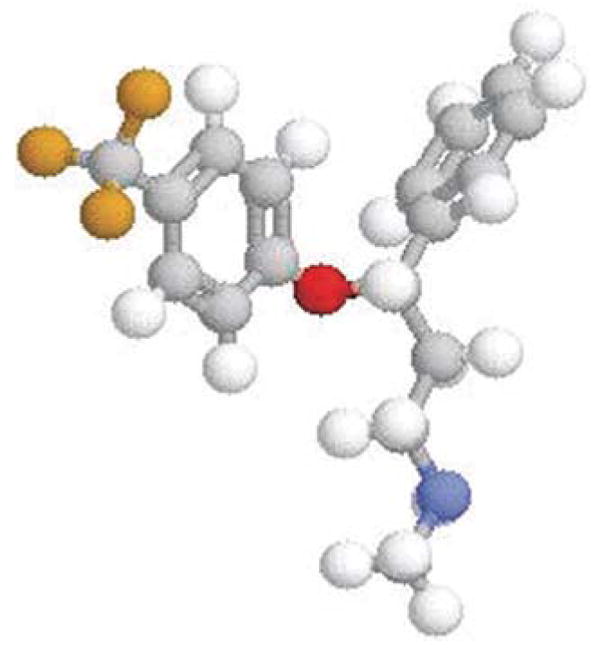
ChemIDplus Prozac Structure
TOXLINE covers much of the standard journal literature in toxicology, as well as an assortment of specialized journals and other sources, including meeting abstracts, technical reports, and research in progress. It also offers features such as relevancy ranking, and flexible sorting and downloading options (see Figure 4).
FIGURE 4.
TOXLINE Record
Hazardous Substances Data Bank or HSDB
The Hazardous Substances Data Bank (HSDB) contains comprehensive toxicological data on over 5,000 chemicals. Like ChemIDplus, HSDB <http://toxnet.nlm.nih.gov/cgibin/sis/htmlgen?HSDB.htm> consists of chemical records, with one record per chemical. The data are organized into categories and data fields/data elements that include human health effects, emergency medical treatment, animal toxicity studies, environmental fate and exposure, standards and regulations, chemical safety and handling, chemical and physical properties, and manufacturing and use information. The information is excerpted from the scientific literature, including handbooks, textbooks, technical reports, and journal articles.
It is particularly important to evaluate the validity and reliability of the summarized data in HSDB, because scientific opinions on the toxicities of certain chemicals often vary widely. For this reason, HSDB data undergoes a rigorous peer review process by the Scientific Review Panel (SRP), a group of 16 scientists and physicians which meets three times a year to examine new or revised HSDB records for accuracy and completeness. Each data statement passing this process is labeled as peer-reviewed. A ‘QC Reviewed’ tag is used for data which has received a quality control review, but has not yet been reviewed by the Scientific Review Panel. Some data in HSDB statements are labeled with an ‘unreviewed’ tag. This information includes data that do not lend themselves to review, such as industry data.4
HSDB can be considered to be “among the most comprehensive sources of information addressing the toxic effects of substances and their impact on health and the environment.”5
WISER®
A companion piece to HSDB is called WISER (Wireless Information System for Emergency Responders) (see Figure 5). WISER is designed to assist emergency responders during hazardous material incidents. It is available as a standalone application for Pocket PCs, Palm OS PDAs, and Microsoft Windows PCs. A Web-based WISER (WebWISER) is also offered for when an Internet connection is available.
FIGURE 5.
WISER Home Page
When handling hazardous material incidents, emergency responders in general, and Hazmat (hazardous materials) units in particular, must make many decisions quickly. They need accurate information about the hazardous substance/s, the emergency resources available, and the surrounding environmental conditions. WISER provides rapid access to the most important information about 400 hazardous substances; comprehensive decision support (including assistance in identification of an unknown substance and, once the substance is identified, guidance on immediate actions necessary to save lives and protect the environment). It features intuitive, simple, and logical user interfaces developed by working with experienced emergency responders.
CONSUMER RESOURCES
NLM has an interest in exploring new ways to foster better understanding of its resources and databases, and in recent years has followed a government-wide effort to make its information more understandable to the general public. Several of its newer products help to address the toxicology and environmental health information needs of the public. One such resource is the Household Products Database (HPD) <http://hpd.nlm.nih.gov> (see Figure 6).
FIGURE 6.
Household Products Database Products
Household Products Database (HPD)
The Household Products Database is a consumer’s guide that provides information on the potential safety and health effects of chemicals contained in more than 6,000 common household products used inside and around the home. It helps users investigate ingredients in brand-name products, in what percentage the ingredients are found, which products contain specific chemical ingredients, who manufactures a specific brand, how the manufacturer can be contacted, what the potential adverse health effects (acute and chronic) of the ingredients in a specific brand are, and what other information is available about such chemicals in the toxicology-related databases of NLM.
HPD can be browsed by product categories or by an alphabetical listing of brand names. Products can also be searched by type, manufacturer, ingredient/chemical name, and by health effects. The record for Page each product shows the ingredients as reported on the product label and/or the manufacturer’s Material Safety Data Sheet (MSDS) <http://hpd.nlm.nih.gov/faq.htm#7> and includes other information such as handling, disposal, and health effects. For more technical information from other NLM resources, users can launch a search for a product or ingredient in TOXNET from the “Product” page in the database. To learn more about the effects of the chemicals on humans in the published biomedical literature, automated searches of NLM’s PubMed are provided from HPD’s “Chemical Information Page” (see Figure 7).
FIGURE 7.
Household Products Database Chemical Information Page
Although NLM does not verify whether the information stated is accurate, current, or complete, the Household Products Database is a good free resource that saves users much time and effort from doing the retrieval themselves.6
Tox Town
Tox Town <http://toxtown.nlm.nih.gov> is an interactive guide to commonly encountered toxic substances and their relationship to human health and the environment. Tox Town helps users explore a town, city, farm, or U.S.-Mexico border community to identify potential environmental hazards; it is recommended for high school and college students, educators, and the concerned public. “Tox Town can also be used to introduce youth and community members to environmental health concepts and raise awareness of, and demand for, quality community planning and building design that can enhance health.”7
Each Tox Town neighborhood is toured by selecting “Location” or “Chemical” links. For example, a user can click on the hospital in the City scene for a list of chemicals that might be found in a hospital and a list of resources about environmental concerns for hospital patients and staff. Or a user can select a chemical, such as mercury, to see where it might be found in a neighborhood and to learn more about it. Cutaway views give an inside look at the school, a home, and other buildings for more detail (see Figure 8).
FIGURE 8.
Tox Town Hospital Cutaway View
Tox Town uses color, graphics, sounds, and animation to convey connections between chemicals, the environment, and the public’s health. It is designed to provide facts on everyday locations where toxic chemicals might be found; information about how the environment can affect human health; nontechnical descriptions of chemicals; links to authoritative chemical information on the Internet; and Internet resources on environmental health topics. Tox Town also offers some resources in Spanish <http://toxtown.nlm.nih.gov/espanol>.
Tox Town’s chemical and environmental information comes from NLM’s TOXNET, MedlinePlus® <http://medlineplus.gov>, and other authoritative sources such as the U.S. Environmental Protection Agency/EPA <http://www.epa.gov> and the U.S. Agency for Toxic Substances and Disease Registry <http://www.atsdr.cdc.gov>. Chemical descriptions are based on TOXNET and other resources and are reviewed by NLM toxicology staff.
ToxMystery
ToxMystery <http://toxmystery.nlm.nih.gov> is NLM’s interactive learning site designed to help children aged 7–10 find clues about toxic substances that may be found in the home (see Figure 9). With lively animations, surprising sound effects, and lots of positive reinforcement, ToxMystery provides a fun, game-like experience, while teaching important lessons about potential environmental health hazards.
FIGURE 9.
ToxMystery
Children visiting ToxMystery have an able guide in “Toxie” the cat, who helps find the hazards hidden in each room and offers hints when needed. The objective is to find all the hazards–in the living room, bathroom, garage, and other areas. Players are treated to fun animations when they identify all the hazards in a room. When all the potential hazards in the house have been discovered, Toxie delivers a special celebration, and players can print a personalized certificate of completion.
ToxMystery’s “Parent Resources” page provides more detailed information about everyday environmental hazards that can be harmful to one’s health. A “For Teachers” page contains more than 10 downloadable activity pages that can be used in elementary school classrooms.
ADDITIONAL NLM RESOURCES
Several of NLM’s newer toxicology and environmental health resources can be useful to both scientific and health professionals as well as to the “concerned citizen.” TOXMAP® is one of these resources.
TOXMAP
TOXMAP <http://toxmap.nlm.nih.gov> is a Geographic Information System (GIS) that uses maps of the United States, and helps users visually explore data from the EPA’s Toxics Release Inventory (TRI) <http://www.epa.gov/tri/> and Superfund Programs <http://www.epa.gov/superfund/index.htm> (see Figure 10). “TOXMAP provides users with a new way to explore and understand a number of toxicology and environmental health resources. Its distinct approach has been especially useful for developing a resource that engages a technology (GIS) and a subject (hazardous chemicals) that may not be familiar to many users.”8
FIGURE 10.
TOXMAP TRI Facilities and Superfund Map
Federal law requires facilities in certain industries that manufacture, process, or use significant amounts of toxic chemicals, to report annually on their releases of these chemicals to the EPA TRI Program. Superfund sites are waste sites in the United States and its territories that contain substances designated as hazardous under the Comprehensive Environmental Response, Compensation, and Liability Act (CERCLA) or other laws.
TOXMAP helps users create nationwide or local area maps showing where TRI chemicals are released on-site into the air, water, and ground. It also identifies the releasing facilities, color-codes release amounts for each year, and provides multi-year chemical release trends, beginning with 1987, when the TRI Program began. Maps also show locations of Superfund sites on the National Priority List (NPL) <http://www.epa.gov/superfund/sites/npl>, listing all chemical contaminants present at these sites. Users can search the system by chemical name, chemical name fragment, and/or location (such as city, state, or ZIP code). TOXMAP also overlays other data onto the maps such as U.S. Census population information, income figures from the Bureau of Economic Analysis, and health data from the National Cancer Institute <http://www.cancer.gov> and the National Center for Health Statistics <http://www.cdc.gov/nchs>.
Haz-Map®
Haz-Map <http://hazmap.nlm.nih.gov> is an occupational health database designed for health and safety professionals and for consumers seeking information about the health effects of exposure to chemicals and biological agents at work. Haz-Map links jobs and hazardous tasks with exposure to chemical and biological agents and occupational diseases and their symptoms (see Figure 11).
FIGURE 11.
Haz-Map Job Record
Information from textbooks, journal articles, and electronic databases such as NLM’s Hazardous Substances Data Bank is classified and summarized to create this resource. The resource’s data are compiled by Dr. Jay A. Brown, MD, MPH, who has over 10 years of experience working in occupational medicine.
Some of Haz-Map’s features include a search capability; browsing by jobs, diseases, symptoms, or agents; and automated searches of TOXNET. Definitions of technical terms are available by selecting hyperlinks to the glossary. Haz-Map also offers a references section. “The references are divided into broad categories: online books and databases, books and compact discs, journals and monographs, and other Web sites …. This feature … expands the universe of available related information.”9
LactMed
NLM’s LactMed <http://lactmed.nlm.nih.gov> is a database of drugs and other chemicals to which breastfeeding mothers may be exposed. It includes information on the levels of such substances in breast milk and infant blood, and the possible adverse effects on breastfeeding and in the nursing infant. Statements of the American Academy of Pediatrics concerning a drug’s compatibility with breastfeeding are provided, as are suggested therapeutic alternatives to those drugs where appropriate (see Figure 12). The information provided includes a “plain language” summary regarding use of the specified drug during lactation, potential alternative medications, and references that are linked to relevant PubMed records. LactMed data are derived from the scientific literature and are fully referenced and peer-reviewed. Supplemental links to breastfeeding resources from credible organizations are also provided.
FIGURE 12.
LactMed Ibuprofen Record
Enviro-Health Links
The NLM’s Enviro-Health Links Web guides <http://sis.nlm.nih.gov/enviro/envirohealthlinks.html> cover toxicology and environmental health topics of recent special interest. The guides include links to information for both the consumer and the professional. Many contain a section on links to laws and policy affecting a topic, for example, regulations having to do with dietary supplement labeling. When possible, the guides have links to relevant books and journal articles that are available for free (see Figure 13).
FIGURE 13.
Several Enviro-Health Links
CONCLUSION
People are increasingly aware of ways in which the environment can affect human health and development. Access to reliable and timely information is vital for understanding potential environmental hazards and to safeguard our health. The National Library of Medicine’s Toxicology and Environmental Health Information Program/TEHIP <http://sis.nlm.nih.gov/enviro.html> has developed a broad range of environmental health products and services that serve researchers, industry, students, and the general public, and will continue to respond to the need for new information products. In the words of one experienced medical librarian, “The resources of… TEHIP deserve a second look by searchers.”10
FOR MORE INFORMATION
More information about the environmental health and toxicology resources of the National Library of Medicine can be found at: <http://www.nlm.nih.gov/pubs/factsheets/tehipfs.html>. The NLM-Tox-Enviro-Health-L e-mail announcement list <http://sis.nlm.nih.gov/enviro/envirolistserv.html> broadcasts updates on NLM’s toxicology and environmental health resources and services, and outreach in toxicology and environmental health.
The TEHIP RSS (Really Simple Syndication) feed <http://sis.nlm.nih.gov/rss/sisnewsfeed.rss> provides information about new resources, updates to NLM toxicology and environmental health databases, and alerts to scientific meetings at which NLM will have exhibits, presentations, or classes.
Questions about these resources can be sent to Dr. Colette Hochstein (colette@nlm.nih.gov) and Ms. Stacey Arnesen (stacey_arnesen@nlm.nih.gov) or to tehip@teh.nlm.nih.gov.
References
- 1.United States. Handling of Toxicological Information. White House; Washington, D.C: 1966. President’s Science Advisory Committee; p. 10. [Google Scholar]
- 2.Wexler Philip. The U.S. National Library of Medicine’s Toxicology and Environmental Health Information Program. Toxicology. 2004 May;198(1–3):161–8. doi: 10.1016/j.tox.2004.01.037. [DOI] [PubMed] [Google Scholar]
- 3.Fitzpatrick Roberta Bronson. Resources from the Toxicology and Environmental Health Information Program (TEHIP) Medical Reference Services Quarterly. 2000 Summer;19(2):65–73. doi: 10.1300/J115v19n02_05. [DOI] [PubMed] [Google Scholar]
- 4.The National Library of Medicine’s Toxicology and Environmental Health -Information Program. Toxicology and Environmental Health Information Resources: The Role of the National Library of Medicine. In: Liverman Catharyn T, Ingalls Carrie E, Fulco Carolyn E, Kipen Howard M., editors. Committee on Toxicology and Environmental Health Information Resources for Health Professionals [and] Division of Health Promotion and Disease Prevention, Institute of Medicine. Washington, DC: National Academy Press; 1997. p. 38. [Google Scholar]
- 5.Prasek Margaret. One-Stop Shopping: The Hazardous Substances Data Bank. Medical Reference Services Quarterly. 1996 Winter;15(4):41–57. doi: 10.1300/J115V15N04_04. [DOI] [PubMed] [Google Scholar]
- 6.Fitzpatrick Roberta Bronson. Are We Safe? NLM’s Household Products Database. Medical Reference Services Quarterly. 2004 Winter;23(4):49–59. [PubMed] [Google Scholar]
- 7.Love Cynthia B, Szczur Martha, Higgins Mary W, Aspinwall Erinn E. Tox Town: An Internet Introduction to Environmental Health and Toxic Chemicals. Children, Youth and Environments. 2005;15(1):307–17. [Google Scholar]
- 8.Hochstein Colette, Szczur Martha. TOXMAP: A GIS-Based Gateway to Environmental Health Resources. Medical Reference Services Quarterly. 2006 Fall;25(3):13–31. doi: 10.1300/J115v25n03_02. [DOI] [PMC free article] [PubMed] [Google Scholar]
- 9.Fitzpatrick Roberta Bronson. HazMap: Information on Hazardous Chemicals and Occupational Diseases. Medical Reference Services Quarterly. 2004 Summer;23(2):49–56. doi: 10.1300/J115v23n04_05. [DOI] [PubMed] [Google Scholar]
- 10.Fitzpatrick Roberta Bronson. Resources from the Toxicology and Environmental Health Information Program (TEHIP) Medical Reference Services Quarterly. 2000 Summer;19(2):65–73. doi: 10.1300/J115v19n02_05. [DOI] [PubMed] [Google Scholar]



